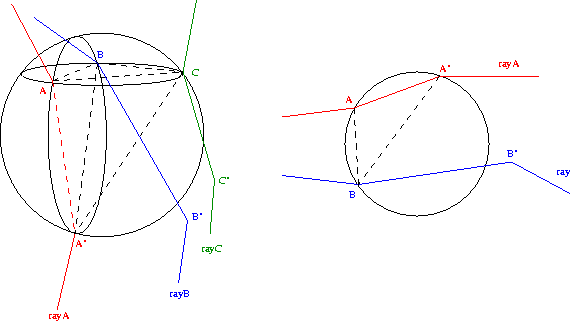




Next: Interpolation
Up: Interpolation algorithm
Previous: Interpolation algorithm
There are at least two methods we can use to obtain the optimal
triangulation. One option is to build a set of triangles (which, of
course, do not intersect) and then to apply an iterative process aimed to
improve the previous triangulation to the constrained Delaunay one. The
second option is to use an incremental algorithm in which to build the
desired Delaunay triangulation in a iterative way, step by step.
We have selected the latter option because it is the fastest and the
implementation is fairly easy. The algorithm we use is to
- 1.
- Iteratively select a group of two rays (in the 2-D case) or three
rays (in the 3-D case) according to the take-off angle(s) so that the entire
data space is eventually covered.
- 2.
- Select two doublets of points (in the 2-D case) or triplets of points
(in the 3-D case) on the considered rays. They act like a base
with two (in 2-D) or three (in 3-D) ``candidate' points.
- 3.
- Analyze all the candidates to see which best fits the
Delaunay criterion. This procedure translates into performing an in-circle
test (in 2-D) or an in-sphere test (in 3-D) O'Rourke (1993).
- 4.
- Advance the base with the point selected at the proceeding item, and
proceed to the next step by selecting a new group of candidate points. Of
course, only one will be different from the proceeding group of
candidates.
circle-sphere
Figure 2 Right: the 2-D case. A and B are the base
points; A' and B' are the candidate points. B' falls outside the circle built
on ABA'; therefore BA' is the next base. Left: the 3-D case. A, B, and, C are
the base points; A', B', and C' are the candidate points. B' and C' fall
outside the sphere built on ABCA'; therefore ACA' is the next base.

A difficult situation appears when the candidate points are not on the same
side of the advancing base. In such cases, it is no longer possible to
apply only the Delaunay criterion. Other rules are needed to get the
correct new base. Our choice is to advance the points on the ray that
restore fastest all the candidate points on the same side of the base. We do so
by saving the ray of the last advance and performing the new advance on one
of the other rays.





Next: Interpolation
Up: Interpolation algorithm
Previous: Interpolation algorithm
Stanford Exploration Project
10/9/1997
